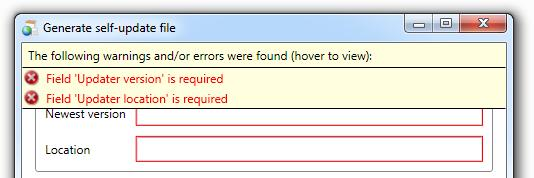Validation controls
There are some very important controls in Catel which help with visualizing the validation results.
InfoBarMessageControl
Ever wanted to show the details of error messages to your end-users? Then, the InfoBarMessageControl is the control to use! The control shows a summary of all business and field errors provided by bindings on objects that implement the IDataErrorInfo interface.

In combination with the WarningAndErrorValidator control, the InfoBarMessageControl can even show field and business warnings for objects that implement the IDataWarningInfo interface that ships with Catel.
<catel:InfoBarMessageControl>
<!-- Actual content here -->
</catel:InfoBarMessageControl>
The InfoBarMessageControl subscribes to the Validation class. This class is responsible for showing the red border around the controls that WPF shows by default. Then, it requests the actual field error property of the data item. This is added to an internal collection of error messages, and therefore the control is able to show the errors of all bindings.
When the WarningAndErrorValidator control is found as a child control, the InfoBarMessageControl also subscribes to the events exposed by the WarningAndErrorValidator. The internal working of that control is explained later in this article. When a data object is subscribed via the WarningAndErrorValidator, the InfoBarMessageControl will also handle the warnings and business errors of that data object.
WarningAndErrorValidator
The WarningAndErrorValidator control is not visible to the end user. The only thing this control takes care of is to forward business errors and warnings to controls that are interested in them. The only control that ships with Catel is the InfoBarMessageControl. Thanks to the WarningAndErrorValidator, the InfoBarMessageControl is able to show business errors and warnings to the end user.
<catel:WarningAndErrorValidator Source="{Binding MyObject}" />
The WarningAndErrorValidator needs to be placed inside an InfoBarMessageControl. The control then subscribes to all property changed events to make sure it receives all change notifications. Then, on every property change, the control checks whether the sender either implements the IDataErrorInfo or IDataWarningInfo interfaces.
When an error or warning is found on the changed property, the control invokes the corresponding events so the InfoBarMessageControl can show the right information. When an error or warning no longer exists in a model, a Removed event is invoked so the InfoBarMessageControl knows that the error or warning should be removed from the summary.
Styling in DataWindow
A InfoBarMessageControl is automatically added to the DataWindow, if you want to use a different style for this InfoBarMessageControl, you must override the default style, add your own InfoBarMessageControl and disable the default InfoBarMessageControl from the DataWindow.
-
Create a custom style based on the default style.
-
Change the x:Key from x:Key="{x:Type local:InfoBarMessageControl}" to x:Key=“yourCustomStyleKey”
-
Set the InfoBarMessageControlGenerationMode to None
/// <summary> /// Initializes a new instance of the <see cref="DataWindow"/> class. /// </summary> /// <param name="viewModel">The view model to inject.</param> /// <remarks> /// This constructor can be used to use view-model injection. /// </remarks> public DataWindow(DataWindowViewModel viewModel) : base(viewModel, DataWindowMode.Custom, null, DataWindowDefaultButton.None, true, InfoBarMessageControlGenerationMode.None) { InitializeComponent(); } -
Add a new
InfoBarMessageControlas root control to yourDataWindowand set the style.<catel:InfoBarMessageControl Style="{DynamicResource yourCustomStyleKey}"> <Grid> <catel:WarningAndErrorValidator Source="{Binding}" /> //Your content </Grid> </catel:InfoBarMessageControl>
Contributions
We would like to thank the following contributors:
Want to contribute to the documentation? We have a guide for that!
Questions
Have a question about Catel? Use StackOverflow with the Catel tag!